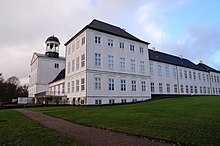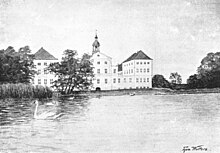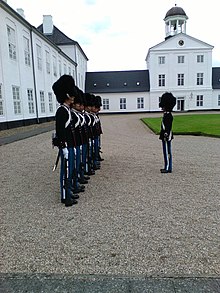Gravenstein Castle
Gravenstein Castle (rarely also Gra f enstein ; Danish : Gråsten Slot ) is the summer residence of the Danish royal family . It is located in Gråsten ( German : Gravenstein ) near Sønderborg (German: Sonderburg ) and the German border. The actual and original name of the castle was Grauenstein , which was translated literally into Danish.
The lock
The castle "to dem graven (gray) stene" was originally built in the years 1700–1708 for Carl von Ahlefeldt , governor of the royal parts of Schleswig and Holstein , in the baroque style. He owned the noble Seegaard- Gravenstein estate. In 1725, Duke Christian August I of Schleswig-Holstein-Sonderburg-Augustenburg bought the castle from him. In 1852 Duke Christian August II was exiled for his position in the Schleswig-Holstein War and in 1852 transferred his possessions, including Gravenstein Castle, to the Danish state. In 1863 his eldest son Friedrich was proclaimed Duke of Schleswig-Holstein. After the German-Danish War in 1864, Bismarck forbade his younger brother Christian to spend his honeymoon there with his English wife Helena of Great Britain and Ireland . After Schleswig-Holstein became a Prussian province in 1867, Friedrich got the castle back. After Northern Schleswig was ceded to Denmark in 1921, the castle fell back to the Danish state, which let the royal family use it.
In 1757 large parts of the complex burned down. In 1758 the castle was rebuilt, with the facades being designed more simply than before. The whitewashed building consists of three wings that enclose a courtyard .
The preserved baroque castle church (Danish: Gråsten Slotskirke ) from 1699 and the castle park laid out in 1700 are worth seeing . The chapel and the park of the castle can be visited from April to October, provided the royal family is absent. Margrethe II and family usually stay at Gravenstein Castle between late June and early August. Traditionally, the royal family arrives with the yacht Dannebrog , which is moored in front of the Sonderburger Castle during the holiday weeks .
Castle Church
The castle church of Gravenstein Castle is one of the few components that survived the devastating fire of 1757. It is embedded in the north wing of the castle and cannot be seen from the outside. The church comes from the renovations of the original castle from the 18th century and has been a parish church since 1851.
The church interior is equipped, among other things, with a large baroque altarpiece that fills the front wall from floor to ceiling. The altarpiece is decorated with sculptures and paintings, framed by columns made of red and white marble. The stucco ceiling is decorated with angels and putti in front of a light blue background that represents the sky. The castle church is richly decorated with paintings, 75 of the original 80 paintings have been preserved.
Castle Park
The palace park is now laid out in the style of an English garden . With her great interest in flowers and gardens, Queen Ingrid had a major influence on the appearance of the gardens today. There is a swimming pool and tennis court in the park. The whole facility is located on a lake.
Changing of the guard
Parades and changing of the guard are events that take place whenever the royal family is visiting. The guard marches from the palace at Ahlefeldvej 4, where the body guards meet at around 11.30 a.m. From here they march, accompanied by flutes and drums, through Gråsten to the castle, where the changing of the guard takes place at 12 noon. During the presence of Queen Margrethe II, you can watch a concert in the courtyard on Fridays as part of the changing of the guard.
Owners list
List of owners of Gravenstein Castle:
- until 1559 Gregers von Ahlefeldt
- 1559–1580 Hans von Ahlefeldt
- 1580–1620 Gregers von Ahlefeldt
- 1620–1648 Hans von Ahlefeldt
- 1648–1686 Duke Filip zu Glücksburg
- 1662–1686 Friedrich von Ahlefeldt the Elder. Ä.
- 1686–1708 Friedrich von Ahlefeldt the Elder. J.
- 1708–1725 Carl von Ahlefeldt
- 1725–1754 Duke Christian August I of Schleswig-Holstein-Sonderburg-Augustenburg
- 1754–1794 Duke Frederik Christian I.
- 1794–1814 Duke Frederik Christian II.
- 1814–1852 Duke Christian August II.
- 1852–1862 The Danish State
- 1862–1864 Count Adam Gotlob Moltke Huitfeldt
- 1864–1865 Prince Christian of Augustenburg
- 1865–1880 Prince Friedrich VIII of Schleswig-Holstein
- 1880–1921 Duke Ernst Günther
- 1921–1935 Danish state ownership
- 1935–2000 King Frederik IX. and Queen Ingrid (right of use only)
- since 2000 Queen Margrethe II. (right of use only)
Others
In 1845, during a nine-day stay at the castle, Hans Christian Andersen wrote the fairy tale The little girl with the sulfur sticks (Danish "Den lille Pige med Svovlstikkerne" ).
See also
List of castles, chateaus and fortresses in Denmark
Individual evidence
- ↑ The letter "V" used to be pronounced as "U" in German texts. In Danish, the "V" is still pronounced as "U". The change in pronunciation also plays a role in the idiom An "X" for a "U" .
- ↑ See Flensburg street names . Society for Flensburg City History, Flensburg 2005, ISBN 3-925856-50-1 , article: Gravensteiner Weg and Kieler Straßenlexikon, author Hans - G. Hilscher ( Memento of the original from April 2, 2015 in the Internet Archive ) Info: The archive link became automatic used and not yet tested. Please check the original and archive link according to the instructions and then remove this notice. , Article: Gravensteiner Straße
- ↑ Danish website Royal House (kongehuset.dk): Officiel modtagelse i Sønderborg og Gråsten, July 15, 2016 (Danish), accessed on July 17, 2016
- ↑ Danish website Königshaus (kongehuset.dk): Historien om Gråsten Slotskirke, July 28, 2017 , (Danish), accessed on July 29, 2017
- ↑ visitsonderborg.de: Gråsten Castle , accessed on July 12, 2017
- ↑ Danish website Königshaus (kongehuset.dk): Vagtskifte på Gråsten Slot (German: Changing of the Guard at Gravenstein Castle), July 21, 2017 (Danish), accessed on July 29, 2017
Web links
- Gråsten Palace - official website of the Danish royal family (English)
- Gråsten Castle (Danish)
- Visitor information on Gravenstein Castle
- filmcentralen.dk: Silent film, 1950, Sommerdage på Gråsten Slot (King Frederik IX and Queen Ingrid during the summer holidays with the three princesses at Gravenstein Castle in 1950)
Coordinates: 54 ° 55 ′ 32.5 " N , 9 ° 35 ′ 43" E





